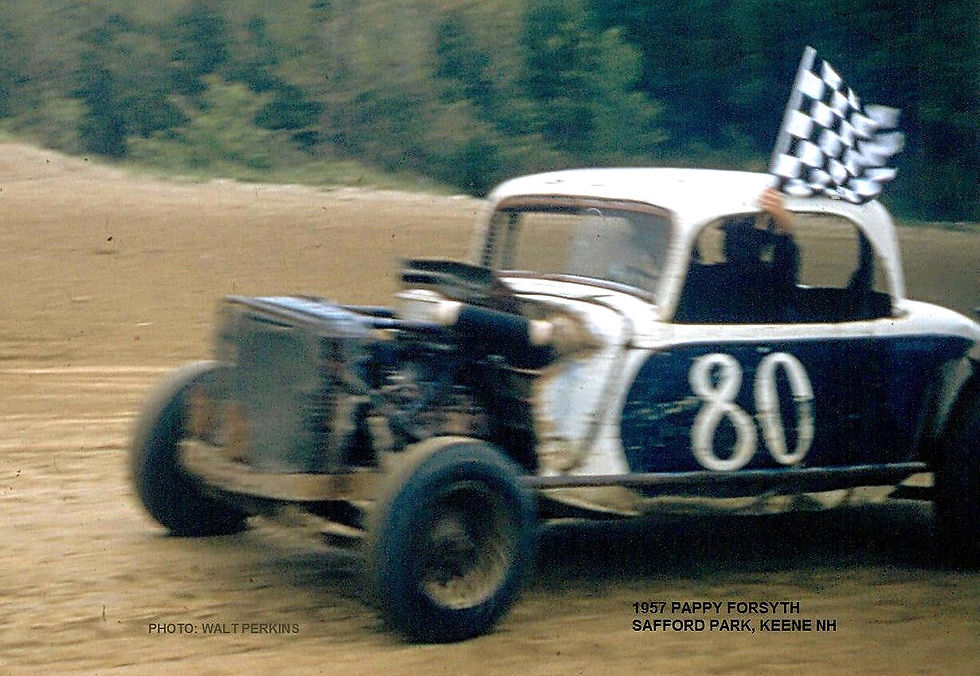A Look Back At Monadnock's Racing Roots
- Nathan Bagster
- Oct 24, 2023
- 4 min read
By Nathan Bagster

(Photo found on Wikicommons)
Just in time for the Cheshire Fair, I decided to jump down the rabbit hole that is racing in the Monadnock Region. While Monadnock Speedway is our most well-known hub for oval track racing, it wasn’t always the star of the show.
So, what does that have to do with the fair? Not much, as fun as the festivities are, we’re actually going to be talking about the fairgrounds themselves. Home to the yearly demolition derby, and visited by the SC Monster Truck Madness, the Cheshire Fairgrounds were once a hub of professional racing known as Safford Speedway.
A significant place in the region's racing roots and the larger narrative of North Eastern stock car racing history, this half-mile dirt track witnessed the evolution of the motorsport from its humble beginnings.
Now, let me first state that a lot of information has been lost to the sands of time, only living in archives and the minds of those who witnessed it. Much of the following was previously collected by Bill Ladabouche, who has a wonderful website dedicated to racetracks in the Northeast - and goes into much more detail, and Ruth Thompson, who wrote an amazing article two years ago on the Lost Dirt Tracks of New Hampshire.
My goal here isn’t to take claim on their leg work but to dig up a bit of history and present it to those who may not be privy. So, without further delay, let’s get to the meat and potatoes.
Safford Speedways' origins can be traced as far back as the mid-1930s when it was known as Safford Park Fairgrounds. The intended use of the grounds was for horse racing, that was until the allure of motorsports beckoned, and Safford followed suit with many fairgrounds across the country. The horse track was soon expanded, made to accommodate the popular open-wheel racing of the time, and erupted into the thunderous roars of combustion engines.
In her article, Ruth points out that ‘With an effortless transition, the drivers and spectators soon discovered that racing a horse was quite a different skill from handling a race car.” And that was made clear with an accident that we’ll get into later on.

(Photo Credit Walt Perkins)
With the spectacle gaining traction, the speedway truly took off near the end of World War II. In the post-war era, the Monadnock Stock Car Racing Association took the reins. They introduced organized stock car racing, and the events quickly began happening on a regular basis. This marked a pivotal turning point for Safford Speedway - propelling it into the spotlight as a professional racing destination.
With its major success came followers, and Safford quickly paved the way for other tracks to be born. With these new tracks, came new drivers and soon racing schedules, which contributed to the thriving race culture of the region and helped to usher in the era of ‘The Coupe.’
In 1954, a significant improvement was made to the track's layout - a 1/3-mile dirt track inside the existing half-mile circuit. This expansion permitted another layer of exhilarating racing action and began drawing attraction from enthusiasts near and far. Not only that, the dual-track setup demonstrated Safford's commitment to innovation and its dedication to providing a top-tier racing experience for both drivers and spectators.
As it grew, Safford played host to a variety of sanctioning bodies, from the MSCRA to the Triangle Racing Association. And each affiliation brought with it a new and diverse range of talented drivers and fans. Soon, the region became a breeding ground for racing legends such as four-time NASCAR National Sportsman Champion Rene Charland and future NASCAR National Modified Champion Ernie Gahan, who graced the track with their presence, leaving an indelible mark on its history.
On Bill’s website, he mentions multiple other historical racers but makes a point of talking about Roy "Pappy" Forsyth, a local racing hero and Keene native, who emerged as a central figure in Safford Speedway's story. Forsyth's racing prowess and leadership skills led him to become the president of the Monadnock Stock Car Racing Association, overseeing the track's operations during its golden years. Under his guidance, the track attracted a roster of formidable drivers and rivaled other renowned tracks like Riverside Park Speedway in Massachusetts.
But with every high, there must come a low, and the track had its share of problems, including an accident in 1935 that took the life of one Bill Howrigan. The official cause of death was implied to be a lack of visibility due to dust, and that coincidentally is one of the concerns that may have shut the track down. Bill states that dirt tracks have a number of usual suspects associated with their eventual closure -dust, noise, and conflicts with another event, and it seems that Safford Speedway may have been no different.

(Photo Credit Walt Perkins)
Now, with the fairgrounds transitioning into a sleepy New England landscape, and the few remnants of the Speedway that remain, the spirit of racing still lingers in the air, reminding us of the vibrant history that once unfolded. And while the exact circumstances leading to the track's closure remain somewhat elusive, its memory endures through the tales of those who witnessed its heyday.
Today, the Cheshire Fairgrounds stand as a testament to the bygone era of racing where wins came from dirty wrenches, busted knuckles, and a sheer drive to have fun. The echoes of those long-forgotten engines live on through events like the derby and Monster Trucks and the taste of competition still flows from Monadnock Speedway and the racing community as a whole.




Comments